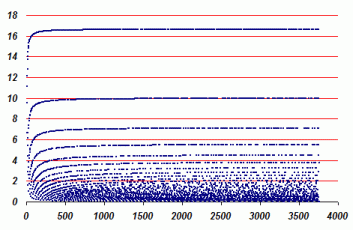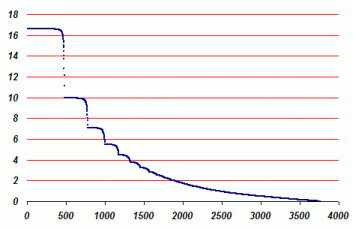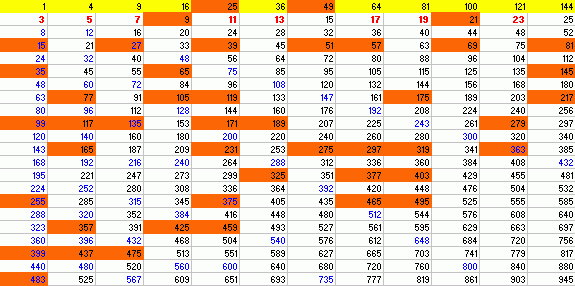
exploring the undesigned
intelligence of the numberverse
First published March 8.
Revised June 23, 2008
Part 1:
The Magic Square of Subtraction: 'A Classic DIscovery'
What is a semiprime?
A natural number that is the product of two prime numbers. *
|
Using the same principle as for perfect square subtraction, the addition of perfect squares to any odd number provides a simple deterministic test for compositeness. |
||||||||||||||||||||||||||||||||||||||||||||||||||||||||||||||||||||||||||||||||||||||||||||||||||||||||||||||||||||||||||||||||||||||||||||||||||||||||||||||||||||||||||||||||||||||||||||||||||||||||||||||||||||||||||||||||||||||||||||||||||||||||||||||||||||||||||||||||||||||||||||||||||||||||||||||||||||||||||||||
I am calling this a test for compositeness, rather than primality, for a couple of reasons:
The basis for a deterministic test predicated solely on the addition of perfect squares can be stated as follows:
By adjacent, I am referring to two perfect squares whose roots are in counting order (so that Ra = Rb + 1). So, for example, 25 and 36 are adjacent because their respective roots - 5 (5*5=25) and 6 (6*6=36) - are separated by 1. As stated in the previous column, every odd number can be created by subtracting two, and only two, successive perfect squares:
There is a further statement we can make about composite numbers that is of great significance because we cannot make it about prime numbers:
The graphic illustrates that 21 is the subtractive product of nonadjacent squares (4 and 25) If you've been paying attention, you may notice a very beautiful fact - namely that for any N the square roots of the nonadjacent squares are the progenitors of its factors. If the number is a semiprime, they are the progenitors of its prime factors. What do I mean by progenitor? The difference between these two square roots gives one factor; the sum of these two square roots gives the other factor. It's that simple - and it's true for every composite that's not a perfect square. Thus, for 21, the square roots of the nonadjacent squares are sqr(4) = 2 and sqr(25) = 5. 5 - 2 = 3 How simple and satisfying is that! If only it were easier to find the nonadjacent squares than it is to find their factors! If such a method exists, it has never been disclosed - and would, in fact, have epic consequences for the theory of complexity classes and the secure application of information technology. If you're interested in Fermat's factorization method, read: There are a few statements that can be made about the nonadjacent perfect squares:
Although it would seem probable that a composite must lie within the span of its nonadjacent squares, this is only consistently the case for the first few composites. For composites greater than 55, the lower nonadjacent square can be less or more than the integer being tested. Let's consider all the odd composites under 100:
Yellow indicates the cases where the lower nonadjacent square is greater than the number being tested. The importance of where the lower nonadjacent square occurs is simply that this is the minimum number of perfect square additions required to prove compositeness. Out of this small sample, the highest number of perfect square additions before finding a nonadjacent pair is 15% of N. It turns out, that this is fairly near the highest percentage for the composites I've investigated so far. The highest "proving ratio" for all composites under 10,000 is 6.006006....: that's 16.65%, or 1/6th of N. Samples in the 105s, 106s, and 107s are just .02% higher: 16.67%, or 5.9988. There is reason to believe that N / ~6 must have some significance. Of all the odd composites under 10,000, 449 out of 3747 have ratios in the 16th percentile. The next largest group are 289 that have have ratios in the 9th percentile. Only 18 composites lie between these two percentiles. All other composites, about 80%, have ratios less than 9%. If you graph it (and you can do this with the downloadable data on these composites), it looks like this:
BTW With N / ~6, a practical perfect square algorithm is possible, but only for numbers less than about 107. Beyond this, the geometric increase in the number of perfect square additions means that the computation time is too great. Even for numbers less than 107, perfect square addition requires many more computations than trial division, which has the great advantage of only needing to consider factors up to the square root of N. The comparison is actually worse than that because with trial division, we also get to divide SqRt(N) by 2 since we can exclude the even numbers. We can't exclude the even perfect squares - they are as important as the odd ones in this algorithm. The arithmetic of the nonadjacent pair For any given odd number, it would appear not much else can be predicted about its nonadjacent pair. Both members of the pair are unknown, and the relationship that may or may not exist is entirely defined by N, if N is a composite number, thus:
Putting the algorithm together Having set realistic expectations for what the perfect-square-addition algorithm will be capable of doing, let's now proceed with formulating exactly what it is. To create a test of compositeness or primality, the middle expression shown above (N + X2 = Y2), requiring addition, is an obvious choice. It only requires adding N to each perfect square from 1 to the upper bound to determine if there exists a product that is equal to another perfect square. We know from the foregoing investigation how many X2s that N must be added to in order to determine compositeness - it's just a tad more than N / 6. In other words, to determine whether such a pair exists for an integer, we must simply add N to every perfect square from 1 through N / 5.9. If we have confidence in N / 5.9, we should also have confidence that we will find that all integers without the property of a nonadjacent square are primes - by elimination: a negative proof of primality. Expressing what has been said as an algorithm, we can begin with stating the two necessary conditions:
Then we need to increment the value of X for every perfect square less than N / 6. But before this we need to add the test that the number being tested is not itself a perfect square (a requirement explained above).
We may also wish to eliminate the trivial cases: all even numbers (they will fail the test anyway) and those divisible by 5 (if we choose to). A JavaScript Implementation The following illustrative demonstration shows that the algorithm is easy to code and effective for relatively small numbers (less than 10,000,000).
Is the algorithm scalable?Without finding an effective strategy for reducing the upper bound or increasing the lower bound, the number of iterations (perfect squares) becomes unmanageable beyond 107. At this point, trial division is still extremely fast - there's really no contest. The problem is there are simply a lot of perfect squares to add N to even if the upper bound holds at N / ~6. For example, a number on the order of 1012 will require at least a 150,000 iterations of the test because there are a 1,000,000 perfect squares under 100,000,000,000. However, it does seem likely that only a discrete subset of perfect square additions have the potential to yield the desired result. This is illustrated in the following section of a matrix generated using the code disclosed in the previous column. The composites of nonadjacent perfect squares have been highlighted in orange. This is what it looks like when the table has 250 columns (or minus squares) - merely the first 250 odd numbers.
You can see right away that only alternating rows participate in finding composites and the other rows are completely even. However, this should not be taken to mean that we only need to test odd perfect squares. If you do this - say, by changing the JavaScript for loop from for (cps = 1; cps <= max; cps++) to for (cps = 1; cps <= (max-1); cps=cps+2) - you will get false prime results for many composites. The reason for this lies in the stepping of the vertical perfect squares. They are alternating odd and even, but you don't see them in the generated worksheet. You have to recall the matrix presented in Part 1. Here, I've highlighted the odd numbers in yellow:
There are other levels of organization in the matrix that need to be studied and might yield improvements in the algorithm. These improvements could possibly produce a far more efficient probabilistic test. However, for now, the perfect square compositeness test has a long way to go before it can rival probabilistic tests (based on FLT) or deterministic tests (based on trial division)..... Your suggestions are welcome!
|
||||||||||||||||||||||||||||||||||||||||||||||||||||||||||||||||||||||||||||||||||||||||||||||||||||||||||||||||||||||||||||||||||||||||||||||||||||||||||||||||||||||||||||||||||||||||||||||||||||||||||||||||||||||||||||||||||||||||||||||||||||||||||||||||||||||||||||||||||||||||||||||||||||||||||||||||||||||||||||||



